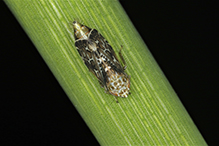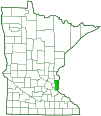Leafhopper
(Errastunus ocellaris)
Conservation • Description • Habitat • Ecology • Distribution • Taxonomy
Conservation Status |
|||
| IUCN Red List | not listed |
||
| NatureServe | not listed |
||
| Minnesota | not listed |
||
Description |
Errastunus ocellaris is a small, exotic leafhopper. Like most leafhoppers, it has no common name. It is native Europe and was introduced into North America as early as 1944. It now occurs across Canada, and in the United States it occurs in Maine south to North Carolina and west to Minnesota. Adults are found in June and July in old fields and lawns feeding on plant juices of grasses, especially non-native ones, and on sedges. Adults are ⅛″ (3.0 to 4.0 mm) long. The background color is milky white with extensive dark brown making the overall appearance dark. The head, the exoskeletal plate covering the thorax (pronotum), and the plate between the wing bases (scutellum) are lighter than the forewings (hemelytra). They are white with orange spots, light brown spots, dark brown spots, or a combination of these. The head is about as wide at the base as the pronotum. There are two large compound eyes and two tiny simple eyes (ocelli). The upper surface of the head (vertex) is broadly triangular and bluntly pointed. It is about as long as the distance between the compound eyes. There are two small triangular marks near the tip (apex), two smaller spots behind these on the margin, and two large irregular spots in the middle. The face, not visible from above, is black. The antennae are short and bristle-like. The pronotum does not extend over the abdomen. The plate between the wing bases (scutellum) is large and triangular, with a spot in each corner and a pair of longitudinal lines down the middle. There are two pairs of wings, and they are held tent-like over the body when at rest. The forewings (hemelytra) are thickened and short. They do not extend to the tip of the abdomen. The hemelytra are comprised of a narrow area (clavus) behind the scutellum when the hemelytra are closed; and the remaining, broad, marginal area (corium). On each hemelytron there is a light brown line on the inner margin (claval commisure) and a light brown line separating the clavus and corium. The clavus and corium are mostly covered with numerous small and large spots. The spots are light brown and at least partially outlined with dark brown. The hindwings are thin, membranous, a little shorter than the hemelytra, and concealed beneath the hemelytra. The last part of the leg (tarsus), corresponding to a foot, has three segments. |
Size |
Total length: ⅛″ (3.0 to 4.0 mm) |
Similar Species |
Habitat |
Old fields, lawns |
Ecology |
Season |
June and July |
Behavior |
|
Life Cycle |
|
Nymph Food |
|
Adult Food |
Plant juices from the leaves of many grasses and sedges, especially non-native grasses. |
Distribution |
||
|
Sources |
|
| 8/26/2025 | ||
Occurrence |
||
|
||
Taxonomy |
|
Order |
Hemiptera (True bugs, Hoppers, Aphids, and Allies) |
Suborder |
Auchenorrhyncha (true hoppers) |
Infraorder |
Cicadomorpha (spittlebugs, cicadas, leafhoppers and treehoppers) |
Superfamily |
Membracoidea (leafhoppers and treehoppers) |
Family |
|
Subfamily |
Deltocephalinae |
Tribe |
Paralimnini |
Subtribe |
Paralimnina |
Genus |
Errastunus |
Subgenus |
Errastunus |
Subordinate Taxa |
|
|
|
Synonyms |
|
Adarrus ocellaris Adarrus tatraensis Cicada ocellaris Cicada ocellata Deltocephalus ocellaris Flexamius ocellaris Iassus ocellaris Jassus ocellaris Latalus ocellaris Latalus sobrinus Latalus tatraensis Thamnotettix ocellaris |
|
Common Names |
|
This species has no common name. The common name of the family Cicadellidae is leafhoppers, and it is applied here for convenience. |
|
Glossary
Corium
The thickened basal portion of the front wing that lies between the clavus and the membrane of insects in the family Hemiptera. Plural: coria.
Hemelytron
The forewing of true bugs (order Hemiptera), thickened at the base and membranous at the tip. Plural: hemelytra.
Ocellus
Simple eye; an eye with a single lens. Plural: ocelli.
Pronotum
The exoskeletal plate on the upper side of the first segment of the thorax of an insect.
Scutellum
The exoskeletal plate covering the rearward (posterior) part of the middle segment of the thorax in some insects. In Coleoptera, Hemiptera, and Homoptera, the dorsal, often triangular plate behind the pronotum and between the bases of the front wings. In Diptera, the exoskeletal plate between the abdomen and the thorax.
Tarsus
On insects, the last two to five subdivisions of the leg, attached to the tibia; the foot. On spiders, the last segment of the leg. Plural: tarsi.
Vertex
The upper surface of an insect’s head.
Visitor Photos |
Share your photo of this insect. |
||
This button not working for you? |
||
|
||
 |
MinnesotaSeasons.com Photos |
|

Slideshows |
|

Visitor Videos |
Share your video of this insect. |
||
This button not working for you? |
||
|
Other Videos |
|

|
Created: 1/22/2020 Last Updated: © MinnesotaSeasons.com. All rights reserved. |


